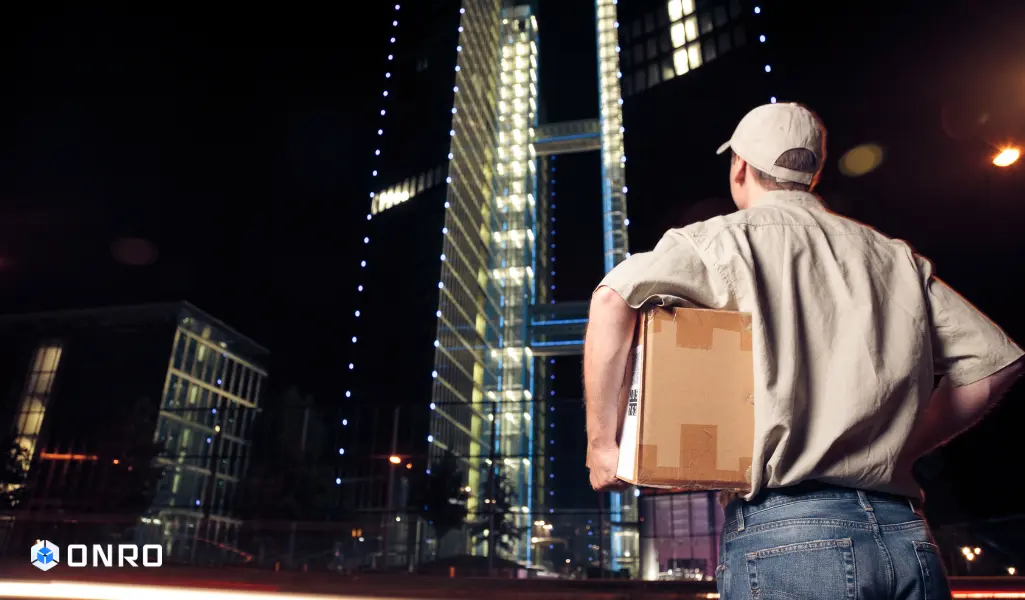What are the top trends in courier services for 2025? With technological advancements, the courier industry is transforming. Automated delivery vehicles, drones, artificial intelligence route optimizers, and combined fleets with all-electric vehicles are bringing a new footprint to the delivery logistics systems. Innovations not only makes the last-mile delivery efficient but also saves costs and helps improve sustainability.
This post specifically aims at the latest trends across the globe in securing future courier services-from intelligent lockers to crowdsourced delivery systems.
1. Autonomous Vehicles: Trends in Courier Services
Traffic congestion, fuel supply logistics, labor shortages, and route changes in the timeline make many of these other disruptions in the last-mile delivery process. Autonomous dispatch and direct route optimization through parcel lockers have been other advancements. However, the other innovations associated with autonomous vehicles completely change the entire concept of logistics and become trends in courier services.
AVs are not only sustainable. They relieve the stresses of labor shortages while reducing operational costs and increasing accessibility. Safety, scalability, and social acceptance have remained hurdles, notwithstanding advances in AI, IoT, and big data. Successful trials in Estonia by DHL and Clevon offered optimism for the future.
2. Drones on Deck: Trends in Courier Services for the Future
The testing of delivery drones has proven to be more than just trial flights; they have a bright future in becoming the answer for last-mile logistics requirements for consumers and business-to-business (B2B) deliveries.
Now, 95% of the costs of delivery are labor when current regulations affect delivery, but innovations ahead in autonomous flight and unmanned traffic systems should drop the cost for each package anywhere from $1.50 to $2. Drones are far more environmentally friendly than electric or gasoline vehicles, making them an important part of future-ready strategies in sustainable delivery ecosystems for retail.
3. Smarter Routes with AI
Route optimization implements machine learning to factor traffic and weather, delivery windows, and vehicle capacity into AI to create the most efficient delivery route. Onro follows trends in courier services and automates planning, thus saving fuel and improving delivery time, thereby creating satisfaction for the customer and making better customer feedback.
This solution mainly includes geocoding, real-time tracking data integration, predictive analytics, smart service zones, and global search. Adaptive route planning in real-time will enhance driving safety, reduce the cost of operation, and decrease empty kilometers using decision-making and multi-constraint routing powered by AI which is the trend in courier services.
4. Mini Warehouses, Big Impact: Trends in Courier Services
Micro-fulfillment centers (MFCs) provide retailers and last-mile operation players with lower operational costs and faster operations. An MFC is essentially a mini-warehouse in the city, which stores materials as close to the customer as possible to minimize shipping time and costs. While these warehouses mainly benefit from enhanced order processing speed, they can also be utilized with automation to reduce manual labor costs.
Nevertheless, micro fulfillment centers add operational complexities to the value chain, demanding prudence in planning their location to achieve optimum cost-effectiveness.
5. Crowdsourced Delivery Platforms
Crowdsourced delivery, or crowd shipping, is, to an extent, a last-mile delivery process that engages independent contractor drivers using technology. It has several advantages like: it is cost-effective, sets up quickly, is more environmentally friendly, and has a customer-centric approach. However, it does have some disadvantages: quality control, legal concerns, and trust issues.
Types of crowdsourced deliveries are peer-to-peer delivery platforms, on-demand delivery, crowd shipping networks, locker solutions, and micro-fulfillment centers. Those issues will need to be resolved in order for any crowdsourced delivery business strategy to be implemented successfully.
6. Omnichannel Retail is No Longer Optional
It is estimated that in 2030, the global omnichannel retail market will reach $27.7 billion. Today, with the advent of e-commerce, companies are finding it essential to convert from single-channel or multi-channel to omnichannel integration, combining online and offline channels into a seamless buying experience.
COVID-19 proved that brick-and-mortar is not enough. In 2025, supply chain organizations will adopt omnichannel strategies in a big way, accompanied by a complete rethink of delivery logistics and supply chain planning.
7. Smart Locker Systems and Technology Acceptance
Smart locker systems have been launched in rural areas (such as hospitals and police stations) to create a better way for parcel collection with various trends in courier services access methods like pin codes, mobile applications, USSDs, or RFID tags.
One important challenge in most rural settings is that roads and addressing systems are hard to find, hindering the activities of logistics services. The survey in the Gqala village, South Africa, analyzed what determines the acceptance of such systems by consumers. Modified UTAUT (EUTAUT) will thus be used to enhance understanding of technology adoption.
8. Electric and Sustainable Fleets (EVs)
Last-mile delivery becomes cost-effective, operates efficiently, and is very green through the use of an electric vehicle (EV). The use of EVs in fleet operations not only reduces maintenance costs but also improves air quality and meets strict emission standards.
Today’s fight to become more competitive would require companies to look to their customers and shippers, who increasingly search for greener alternatives. Thus, shifting to electric vehicles will help them secure this dual advantage of creating profit and providing positive effects on the environment – creating a more sustainable future for logistics.
9. Robotic Delivery Assistants: Trends in Courier Services
Serve robotics has revolutionized the concept of last-mile deliveries by autonomously making sidewalk robots a reality. These robots have now been entered into service for food delivery, from things that need to be returned under the mediation of Uber Eats and Wing. So, robotic delivery is a trend in courier services.
From Los Angeles, it also provides services in specific areas. All these robots are designed to be operated in a level 4 autonomy, where LiDAR will be used as a means for safe navigation. There is, by way of example, this bold vision to roll out 2,000 bots by the year 2025; they are reducing but becoming more efficient in areas now serviced by humans.
Also, they’ll stretch much farther than pharmacy goods to small local commerce, and it will change dramatically the landscape of delivery into the cities in those efficient, affordable ways.
10. Contactless Delivery Tech
Modern handover has taken a new turn to offer safety and convenience with QR codes and NFC. It is incorporated into the seamless benefits of payment transactions so that protection is offered with no contact. It is also a good trend in courier services for touch-free pickup, hence complying with the health and safety protocols for very minimal handling short, it’s today’s safety-minded way of life.
11. Subscription-Based Deliveries
Increasing transparency, safety, and efficiency in last-mile delivery by blockchain drastically transforms the process, providing end-to-end traceability, tamper-proof record keeping, and automation via smart contracts.
Live package tracking, safe payment, and collaborative logistics are among the applications. It helps in inventory and returns management and gives confidence to customers toward the service. While it still faces obstacles of scalability and integration, the more innovations and acceptance flow in, the more transparent and cost-effective it will become for e-commerce logistics.
12. Dynamic Pricing for Last-Mile Services
However, pricing decisions become quite difficult because of the cost variability associated with reverse logistics, urban space congestion, and increasing customer demands attributed to the last-mile in logistics as an important concern for supply chains. So, the next trend in courier services in 2025 is dynamic pricing.
Fuel costs, reduced delivery times, and free, fast shipping claims push up the cost of operations and entice firms to work with AI-powered routing optimization, dynamic pricing, and collaborative logistics for configurations that balance customer needs with profitability. The focus is on such optimizations that allow delivery cascading in a model that does not stretch pricing.
13. Predict, Decide, Deliver: The Power of Data in Courier Services
Prescriptive analytics are the means whereby you get to understand what is going to happen and, more importantly, what to do about it. Big data and prediction tools can indicate demand and optimize materials flow, but prescriptive analytics strengthen the process of decision-making as trends in courier services.
The worldwide prescriptive analytics market will be valued at $9.56 billion in 2024 and is expected to reach an astounding $82.31 billion by the year 2034, with a rate of growth of 24.2% per year, thus becoming an inevitable partner in the future logistics.
14. Upselling Through the Last-Mile: A New Trend in Courier Services
The fact is that upselling via the delivery experience is gaining importance by changing delivery drivers into salespersons armed with data. With customer shopping behavior and supply chain digitization, the drivers can restock their unsold stock based on their purchase histories. It boosts revenue, minimizes delivery costs, and increases customer service because customers would want that item, they forgot in the shopping cart to arrive right on their doorstep.
With this growing customer appetite for convenience, it would not be surprising if, within two to three years, upselling delivery services would experience a boom.
FAQ | Trends in Courier Services
With the latest technologies such as autonomous vehicles, drones, AI-powered route optimization, and electric fleets, the transformation of the courier industry is easily visible. These trends are noted for speeding up the process of delivery, greening it, and reducing its cost.
Autonomous vehicles enhance courier services through increased efficiencies, labor shortages, and reduced costs of operations; they also warrant optimizations of routes and environmental sustainability thus redefining the future of logistics.
Last-mile delivery has become one of the major stems into which couriers and logistics companies are beginning to invest. It initiates speedy shipping solutions but lowers the cost. This will eventually mean saving on human resources while cutting down carbon emissions. It is part of an environmentally sustainable means of couriering.
Conclusion
As with any major trends in courier services focusing on efficiency, sustainability, and cost-effectiveness, courier services have to develop and keep up. Everything shaping last-mile delivery is from AI providing route optimization to the new enhancements seen, which include electric fleets. Would you like to experience such changes? Get a free demo today of Onro’s advanced courier delivery software and see the advantage they can offer your courier services during such times of delivery.
Try Onro for Free
Get your free access to the Onro Fully White-label Courier Software.



